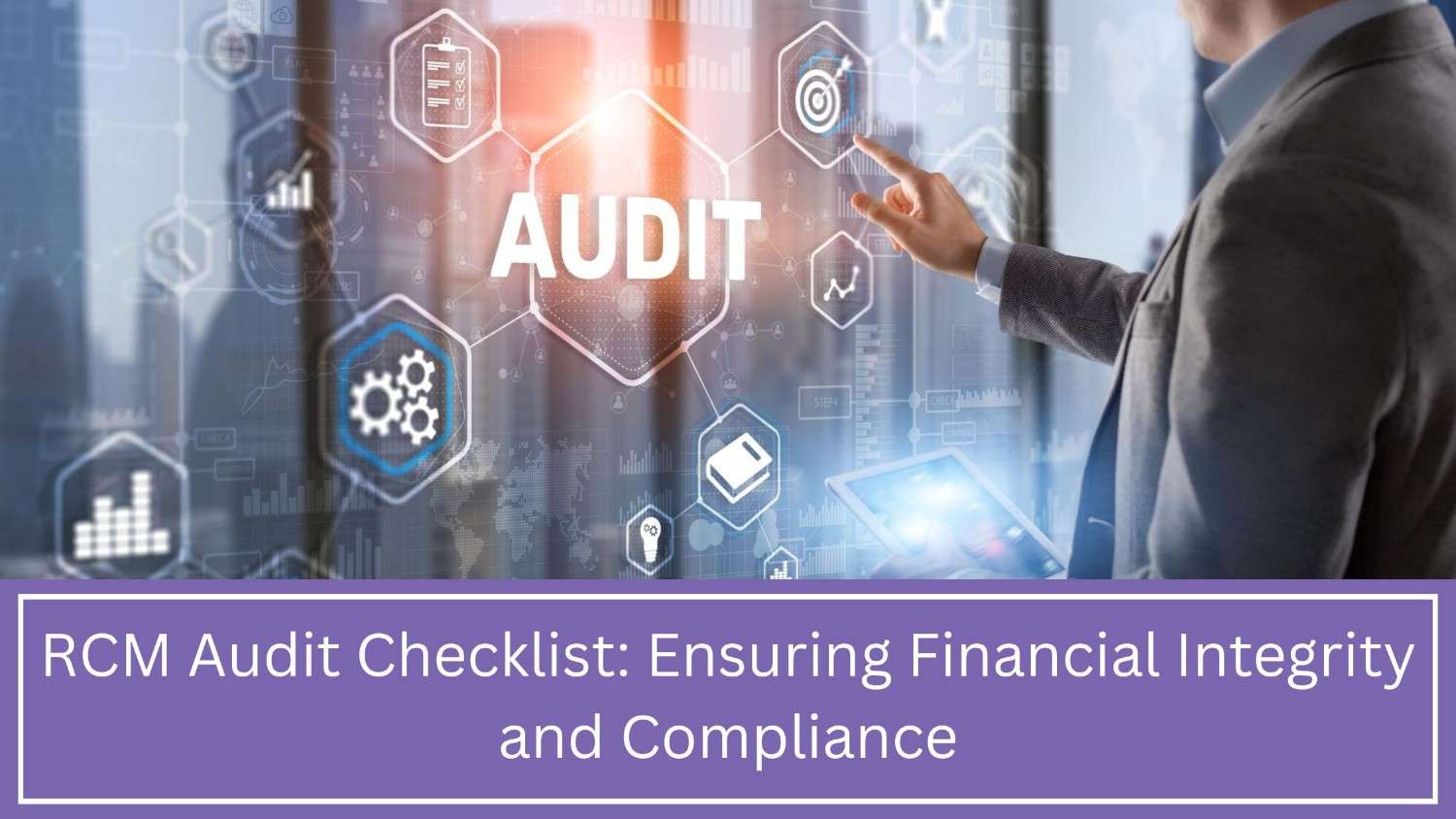RCM Audit Checklist Secure Compliance and Revenue
RCM Audit Checklist Secure Compliance and Revenue Audits in revenue cycle management are essential for maintaining financial accuracy, compliance, and stability. This blog explores the complete RCM audit checklist, covering every step from patient registration and coding to payment posting and denial management. Discover how to identify billing errors, boost claim approval rates, and ensure strong compliance. With emerging trends like AI-driven checks, automation, and new transparency regulations, RCM audits have become more critical than ever. Read on to learn how regular audits can safeguard your practice’s revenue and how Practolytics empowers you to achieve financial stability and sustainable growth.
Table of Contents
RCM Audit Checklist: Ensuring Financial Integrity and Compliance
Why RCM Audits Matter More Than Ever
In healthcare, money flows through many steps and systems. Patient registration, claim submission, and payment posting—each must work right. Small mistakes like wrong patient information or overlooked payer updates result in lost revenue, compliance roadblocks, and cash flow issues.
Healthcare Revenue Cycle Management services (RCM) audits can fix this. A proper RCM audit oversees every billing stage to ensure data precision, compliance, and timely payments. It’s not just about capturing errors but also developing strong financial stability for the long term.
A 2024 MGMA survey found medical practices lose 10–15% of yearly revenue from poor RCM oversight. Regular audits prevent that loss. This blog covers the full RCM Audit Checklist—what to review, how to do it, and why it’s vital for compliance and growth.
Understanding RCM Audits
An RCM audit checks every step of your revenue cycle. It makes sure claims move smoothly from medical billing to payment—keeping things accurate, compliant, and efficient.
Why Run an RCM Audit?
- Spot billing mistakes and missed charges.
- Find underpayments and denied claims.
- Confirm you follow payer contracts and regulations.
- Push claims out faster and error-free.
- Boost your team’s results with real data.
Run audits internally with your staff or hire outside experts. Best practice? Do quick checks quarterly and deep dives yearly.
The RCM Audit Checklist—Step-by-Step
Step 1: Front-End Check – Patient Registration & Coverage
Revenue starts at check-in. Get this right.
Checklist:
- Patient details: All correct?
- Is insurance verified on every visit?
- Authorization on file?
- Copays/deductibles collected upfront?
- Data entered cleanly into EHR?
Why:
30% of claim denials come from messy registration—wrong IDs, expired coverage, or missing paperwork. Catch errors early. Save cash.
Step 2: Coding & Charge Audit
Bill accurately for every service. No guesswork.
Checklist:
- CPT/ICD-10 codes current?
- Do the codes match the notes?
- Modifiers used properly?
- No undercoding or overcoding?
- Missing charges tracked?
Impact:
Bad coding drains 15% of revenue yearly. Audits slash compliance risks and false billing.
Pro tip:
Match codes to clinical notes. Every charge needs proof.
Step 3: Claims Management Audit
Claims drive your cash flow. This step ensures they’re handled right.
Checklist:
- Clean claims before sending?
- First Pass Yield (FPY)—claims paid without resubmission?
- Denied claims fixed fast?
- Staff using payer-specific rules?
- Claims filed on time?
Industry Standard:
Top groups hit 95%+ FPY. Lower? Check coding or paperwork errors.
Step 4: Payment Posting Audit
Match payments to what you’re owed.
Checklist:
- Payments logged quickly and correctly?
- Adjustments approved properly?
- Remittance matched to claims?
- Underpayments chased?
- Patient balances updated live?
Reality Check:
Delayed payments or wrong adjustments skew finances. Regular checks keep revenue honest.
Smart Move:
Automate the reconciliation process with the payer portal for quicker posting and fewer mistakes.
Step 5: Denial Management Audit
Denials happen—but smart handling boosts your bottom line.
Quick Checks:
- Are denial reasons tracked by type?
- What’s your denial rate? (Claims denied ÷ Claims submitted)
- Are appeals filed before deadlines?
- Are root causes fixed? (Like coding errors or missing data)
- Are repeat denials stopped?
Key Stats:
RevCycleIntelligence reports that 20% of claims get denied initially. Fix them fast—you can recover 60%.
Action Tip:
Assess denial trends every month. If one payer continues to reject even after multiple submissions, work and adjust your process or appeal method.
Step 6: Compliance and Policy Audit
Maintaining compliance protects your practice from penalties, fines, and other major legal troubles.
Quick Checks:
- Do all processes follow CMS, HIPAA, and OIG rules?
- Are payer contracts and fee schedules updated?
- Are surprise billing and price transparency laws followed?
- Are coding/documentation audits done quarterly?
- Are patient billing and refund policies solid?
2025 Update:
The No Surprises Act and Transparency Rule now necessitate proper cost estimates upfront. Auditors look for unexpected patient bills.
Step 7: Accounts Receivable (A/R) and Collections Audit
Your A/R report spots the speed at which you collect payments.
Checklist:
- What’s your average Days in A/R?
- What’s your A/R split by age (0–30, 31–60, 61–90+ days)?
- Are overdue claims chased weekly?
- Are unpaid balances managed with patient-friendly options?
- Are the collection steps logged and legal?
Industry Trend:
By 2025, A/R automation will slash unpaid bills by 25%, particularly with automated reminders and online payment options.
Step 8: Reporting and Analytics Audit
This step checks your performance progress.
Checklist:
- Are KPIs monitored weekly and monthly?
- Do managers review clean claim rate, denial rate, and net collection rate?
- Are dashboards used for live updates?
- Is there a feedback loop between billing, medical coding, and front-desk teams?
Top Metrics to Track:
|
METRIC |
IDEAL TARGET |
|
Clean Claim Rate |
> 95% |
|
Denial Rate |
< 5% |
|
Days in A/R |
< 35 days |
|
Net Collection Rate |
> 95% |
|
First Pass Yield |
> 90% |
Data-driven audits ensure the entire team focuses on measurable results, not assumptions.
Common Audit Findings in Healthcare Practices
Even the best teams slip up. Common audit catches include:
- Old payer contracts are missing updated rates.
- Claims without modifiers or medical necessity notes.
- Staff untrained on new codes (like telehealth).
- Incomplete or unsigned provider notes.
- Mistakes in tracking write-offs and underpayments.
Bottom line: Tiny gaps drain revenue fast. Regular audits spot them early—before profits bleed out.
2025 RCM Audit Trends and Insights
RCM auditing keeps evolving—here’s what matters now:
AI Checks Claims Fast:
Artificial Intelligence goes through thousands of claims in an instant, capturing errors or missing information with near-perfect precision.
Early problem detection:
New tools predict billing risks such as overcharges or compliance gaps *before* claims get submitted.
One Screen for Everything:
Healthcare leaders make use of real-time dashboards that bring together billing, financial, and patient data for live insights.
Expert Outsourcing:
Many teams partner with specialized RCM firms for unbiased audits using advanced tech.
Clear Patient Costs:
Audits now verify patients understand their bills upfront, meeting strict transparency rules.
How to Make Audits a Routine, Not a Rescue Plan
Many practices only audit after problems hit—like cash flow drops or fines. But top performers treat audits like regular health checks, not crisis fixes.
Keep Your Audits Strong:
- Do quick monthly checks on registrations and denials.
- Run full coding reviews every quarter.
- Put one RCM lead in charge—no confusion.
- Automate repeat checks with software.
- Review payer contracts yearly.
When audits are routine, your team stays sharp, compliant, and lean.
The Real Benefit—Financial Integrity and Trust
RCM audits do more than count dollars. They build trust and accountability—within your team and with patients and payers.
Regular audits help practices:
- Recover lost revenue.
- Avoid compliance fines.
- Strengthen payer partnerships.
- Boost billing accuracy and staff morale.
- Build patient loyalty through honest billing.
Audits transform confusion into control—and control into steady cash flow.
Conclusion: Strengthen RCM Audits and Compliance with Practolytics
An RCM audit isn’t a box-ticking exercise—it’s your revenue cycle’s steady pulse. Audit consistently, and your cash flow stabilizes.
Practolytics streamlines RCM audits with automated tools, compliance checks, and live analytics—all centralized.
With us, you:
- Automate claim reviews to reclaim staff hours.
- Receive instant flags for coding gaps or paperwork issues.
- Oversee A/R aging, claim accuracy, and compliance KPIs through live dashboards.
- Sync every audit report with CMS payer needs.
- Recover lost revenue while cutting compliance exposure.
Practolytics helps healthcare teams transform audits into results—securing revenue, boosting compliance trust, and safeguarding finances.
Want clarity and command over your revenue cycle?
Contact Practolytics today for a free RCM audit consultation. See how automated insights fortify your financial health.
ALSO READ – Essential Tips for Error-Free Orthopedic Billing and Coding: Boost Your Practice’s Financial Health
Talk to Medical Billing Expert Today — Get a Free Demo Now!






